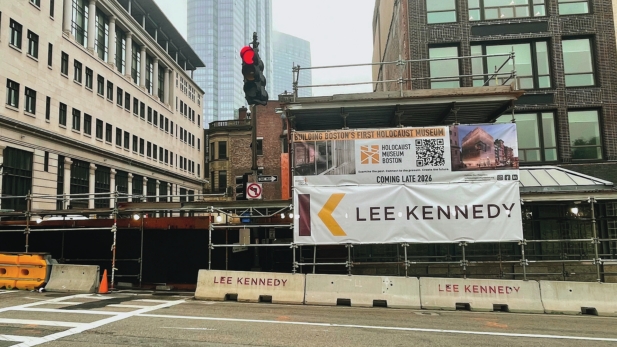
Construction has begun for Boston’s new Holocaust museum after a groundbreaking ceremony held late last month.
Holocaust Museum Boston, funded by the Holocaust Legacy Foundation, will sit at the northeast end of the Boston Common on Tremont Street, across from the Park Street Church. That puts it on the Freedom Trail, diagonally opposite the historic Central Burial Ground, and down the street from the State House.
“The museum will build on our city’s legacy as a symbol of democratic ideals and collective action,” Jody Kipnis, a co-founder of the museum, said in a phone call. “Being located near historical landmarks, it gives us the opportunity to challenge visitors, to confront the past and reflect on their own role in safeguarding justice and equality. The museum will encourage the visitor to move beyond asking, ‘What would you have done?’ and instead to, ‘Who will you be now?’”
The
project’s current estimated cost is $100 million. Kipnis said she and
museum co-founder Todd Ruderman had given the first gift of $50 million,
and that the Massachusetts Senate and House of Representatives had each
agreed to grant another $5 million. The building is slated to open in
late 2026.
Architecture
firm Schwartz/Silver handled the design of the museum. Jon Traficonte,
the project’s design principal, said the firm wanted to make the most of
its location.
“In our
opinion it needed to be more of a beacon,” Traficonte said. “It should
not necessarily visually compete with the Park Street steeple at night,
but still, it needs to hold the corner.”
Renderings
of the museum show a white curtain-like facade, which Traficonte said
would glitter in the sunlight and have a subtle warm glow at night. On
the second level, the curtains are pulled back from an extended bay
window. The window contains an authentic railcar used to transport Jews
to Nazi death camps, which passers-by will be able to see from the
street.
In a speech at
the groundbreaking event, Kipnis said that she had changed her mind
several times about where to place the railcar in the museum. But she
said later in a phone call, the inspiration for the bay window had
struck her while traveling in Spain.
“I
was walking down the street and saw this corner window, and I don’t
know. I just visualized the railcar there, on this very busy street,”
Kipnis said. Looking up at the window, people will be able to see
visitors entering the railcar, but not exiting it, which Kipnis said was
part of the greater symbolism of the museum. “It really is about this
expression of optimism,” Traficonte said. “The national Holocaust Museum
is a heavy, massive building. It portrays this solemn nature. We wanted
the exhibits to tell that story, but we wanted visitors to leave with
the intention of making an impact from what they saw. Not leaving
feeling like there’s no hope, but feeling like they can make sure that
things aren’t forgiven and that they’re inspired to make change.”